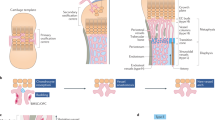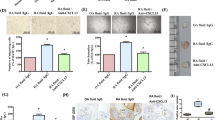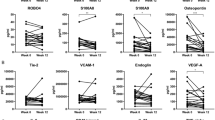Abstract
Angiogenesis, the development of new vessels, is an important process in health and disease. The perpetuation of neovascularization in inflammatory diseases, such as rheumatoid arthritis, spondyloarthropathies and some systemic autoimmune diseases, might facilitate the ingress of inflammatory cells into the synovium and, therefore, stimulate pannus formation. Disorders associated with perpetuated neovascularization are considered to be angiogenic inflammatory diseases. Several angiogenic mediators, including growth factors, cytokines, matrix metalloproteinases, matrix macromolecules, cell adhesion receptors, chemokines and chemokine receptors, have been implicated in the process of capillary formation. There is a regulatory network in inflamed tissues that is involved in the upregulation or downregulation of angiogenesis. Endogenous angiostatic factors downregulate neovascularization and might act as angiostatic agents. Furthermore, angiogenesis might be targeted by several specific approaches that could be therapeutically used to control inflammatory diseases.
Key Points
-
Angiogenesis, the formation of new vessels, is a key mechanism involved in leukocyte ingress through the vascular endothelium into sites of inflammation
-
Numerous inflammatory rheumatic diseases, including rheumatoid arthritis, spondyloarthropathies and systemic lupus erythematosus, can be considered to be angiogenic diseases, as they are associated with intensive angiogenesis
-
In inflammation, there is an imbalance between angiogenic and angiostatic mediators, leading to the perpetuation of neovascularization
-
Angiogenic mediators and inhibitors include cytokines, chemokines, growth factors, adhesion molecules, proteases, and synthetic compounds
-
There is a regulatory network in inflamed tissues, which is involved in the control of angiogenesis
-
Specific targeting of angiogenesis might be used as a therapeutic approach to control inflammation
This is a preview of subscription content, access via your institution
Access options
Subscribe to this journal
Receive 12 print issues and online access
$209.00 per year
only $17.42 per issue
Buy this article
- Purchase on Springer Link
- Instant access to full article PDF
Prices may be subject to local taxes which are calculated during checkout


Similar content being viewed by others
References
Koch AE (1998) Angiogenesis: implications for rheumatoid arthritis. Arthritis Rheum 41: 951–962
Szekanecz Z, Koch AE (2001) Chemokines and angiogenesis. Curr Opin Rheumatol 13: 202–208
Bodolay E et al. (2002) Angiogenesis and chemokines in rheumatoid arthritis and other systemic inflammatory rheumatic diseases. J Cell Mol Med 6: 357–376
Auerbach W, Auerbach R (1994) Angiogenesis inhibition: a review. Pharmacol Ther 63: 265–311
Szekanecz Z et al. (2005) Angiogenesis in rheumatoid arthritis. Front Biosci 10: 1739–1753
Walsh DA (1999) Angiogenesis and arthritis. Rheumatology (Oxford) 38: 103–114
Veale DJ, Fearon U (2006) Inhibition of angiogenic pathways in rheumatoid arthritis: potential for therapeutic targeting. Best Pract Res Clin Rheumatol 20: 941–947
Distler JH et al. (2006) Angiogenesis and vasculogenesis in systemic sclerosis. Rheumatology (Oxford) 45 Suppl 3: iii26–iii27
Murakami M et al. (2006) Signalling of vascular endothelial growth factor receptor 1 tyrosine kinase promotes rheumatoid arthritis through the activation of monocytes/macrophages. Blood 108: 1849–1856
Yin G et al. (2002) Endostatin gene transfer inhibits joint angiogenesis and pannus formation in inflammatory arthritis. Mol Ther 5: 547–554
Agarwal SK, Brenner MB (2006) Role of adhesion molecules in synovial inflammation. Curr Opin Rheumatol 18: 268–276
Szekanecz Z et al. (1998) Cytokines in rheumatoid arthritis: potential targets for pharmacological intervention. Drugs Aging 12: 377–390
Brennan F, Beech J (2007) Update on cytokines in rheumatoid arthritis. Curr Opin Rheumatol 19: 296–301
Szekanecz Z, Koch AE (2007) Macrophages and their products in rheumatoid arthritis. Curr Opin Rheumatol 19: 289–295
Cotran RS, Pober JS (1990) Cytokine-endothelial interactions in inflammation, immunity and vascular injury. J Am Soc Nephrol 1: 225–235
Szekanecz Z, Koch AE (2004) Vascular endothelium and immune responses: implications for inflammation and angiogenesis. Rheum Dis Clin N Am 30: 97–114
Koch AE et al. (1994) Vascular endothelial growth factor. A cytokine modulating endothelial function in rheumatoid arthritis. J Immunol 152: 4149–4156
Kiselyov A et al. (2007) VEGF/VEGFR signaling as a target for inhibiting angiogenesis. Expert Opin Investig Drugs 16: 83–107
Hernandez GL et al. (2001) Selective inhibition of vascular endothelial growth factor-mediated angiogenesis by cyclosporin A: roles of the nuclear factor of activated T cells and cyclooxygenase 2. J Exp Med 193: 607–612
Giatromanolaki A et al. (2003) Upregulated hypoxia inducible factor-1α and -2α pathway in rheumatoid arthritis and osteoarthritis. Arthritis Res Ther 5: R193–R198
Park CC et al. (2001) Evidence of IL-18 as a novel angiogenic mediator. J Immunol 167: 1644–1653
Angiolillo AL et al. (1997) Interleukin-15 promotes angiogenesis in vivo. Biochem Biophys Res Commun 233: 231–237
Numasaki M et al. (2005) IL-17 enhances the net angiogenic activity and In vivo growth of human non-small cell lung cancer in SCID mice through promoting CXCR2-dependent angiogenesis. J Immunol 175: 6177–6189
Markham T et al. (2006) Regulation of endothelial activation and down-regulation of Tie2 receptor in psoriatic skin after infliximab therapy. J Am Acad Dermatol 54: 1003–1012
Fearon U et al. (2006) Oncostatin M induces angiogenesis and cartilage degradation in rheumatoid arthritis synovial tissue and human cartilage cocultures. Arthritis Rheum 54: 3152–3162
Amin MA et al. (2003) Migration inhibitory factor mediates angiogenesis via mitogen-activated protein kinase and phosphatidylinositol kinase. Circ Res 93: 321–329
Morand EF et al. (2006) MIF: a new cytokine link between rheumatoid arthritis and atherosclerosis. Nat Rev Drug Discov 5: 399–410
Kim HR et al. (2007) Macrophage migration inhibitory factor upregulates angiogenic factors and correlates with clinical measures in rheumatoid arthritis. J Rheumatol 34: 927–936
Strieter RM et al. (1995) The functional role of the ELR motif in CXC chemokine-mediated angiogenesis. J Biol Chem 270: 27348–27357
Pablos JL et al. (2003) Synoviocyte-derived CXCL12 is displayed on endothelium and induces angiogenesis in rheumatoid arthritis. J Immunol 170: 2147–2152
Salcedo R et al. (2000) Human endothelial cells express CCR2 and respond to MCP-1: direct role of MCP-1 in angiogenesis and tumor progression. Blood 96: 34–40
Stamatovic SM et al. (2006) CCL2 regulates angiogenesis via activation of Ets-1 transcription factor. J Immunol 177: 2651–2661
Nanki T et al. (2000) Stromal cell-derived factor-1-CXC chemokine receptor 4 interactions play a central role in CD4+ T-cell accumulation in rheumatoid arthritis synovium. J Immunol 165: 6590–6598
Madri JA, Williams KS (1983) Capillary endothelial cell cultures: phenotypic modulation by matrix components. J Cell Biol 97: 153–165
Hong KH et al. (2007) Effect of interleukin-4 on vascular endothelial growth factor production in rheumatoid synovial fibroblasts. Clin Exp Immunol 147: 573–579
Boulday G et al. (2006) Vascular endothelial growth factor-induced signaling pathways in endothelial cells that mediate overexpression of the chemokine IFN-gamma-inducible protein of 10 kDa In vitro and in vivo. J Immunol 176: 3098–3107
Komano Y et al. (2006) Identification of a human peripheral blood monocyte subset that differentiates into osteoclasts. Arthritis Res Ther 8: R152–R158
Senger DR et al. (1997) Angiogenesis promoted by vascular endothelial growth factor: regulation through α1β1 and α2β1 integrins. Proc Natl Acad Sci USA 94: 13612–13617
Cho ML et al. (2007) Toll-like receptor 2 ligand mediates the upregulation of angiogenic factor, vascular endothelial growth factor and interleukin-8/CXCL8 in human rheumatoid synovial fibroblasts. Immunol Lett 108: 121–128
Jones PB et al. (1994) Endothelial cell stimulating angiogenesis factor a new biological marker for disease activity in ankylosing spondylitis? Br J Rheumatol 33: 332–335
Drouart M et al. (2003) High serum vascular endothelial growth factor correlates with disease activity in spondylarthropathies. Clin Exp Immunol 132: 158–162
Robak E et al. (2002) Circulating angiogenesis inhibitor endostatin and positive endothelial growth regulators in patients with systemic lupus erythematosus. Lupus 11: 348–355
Koch AE et al. (1992) Decreased monocyte-mediated angiogenesis in scleroderma. Clin Immunol Immunopathol 64: 153–163
Hebbar M et al. (2000) Increased concentrations of the circulating angiogenesis inhibitor endostatin in patients with systemic sclerosis. Arthritis Rheum 43: 889–896
Margheri F et al. (2006) Domain 1 of the urokinase-type plasminogen activator receptor is required for its morphological, functional β2 integrin-mediated connection with actin cytoskeleton in human microvascular endothelial cells: failure of association in systemic sclerosis endothelial cells. Arthritis Rheum 54: 3926–3938
Konttinen YT et al. (2004) Disease-associated increased HIF-1, αVβ3 integrin and Flt-1 do not suffice to compensate the damage-inducing loss of blood vessels in inflammatory myopathies. Rheumatol Int 24: 333–339
Terai M et al. (1999) Vascular endothelial growth factor in acute Kawasaki disease. Am J Cardiol 83: 337–343
Csernok E et al. (1996) Transforming growth factor-β (TGF-β) expression and interaction with proteinase 3 (PR3) in anti-neutrophil cytoplasmic antibody (ANCA).associated vasculitis. Clin Exp Immunol 105: 104–109
Cid MC et al. (2002) Tissue and serum angiogenic activity is associated with low prevalence of ischemic complications in patients with giant-cell arteritis. Circulation 106: 1664–1671
Guttmann-Raviv N et al. (2007) Semaphorin-3A and semaphoring-3F work together to repel endothelial cells and to inhibit their survival by induction of apoptosis. J Biol Chem 282: 26294–26305
Goedkoop AY et al. (2004) Deactivation of endothelium and reduction in angiogenesis in psoriatic skin and synovium by low dose infliximab therapy in combination with stable methotrexate therapy. Arthritis Res Ther 6: R326–R334
Bongartz T et al. (2005) Treatment of active psoriatic arthritis with the PPARγ ligand pioglitazone: an open-label pilot study. Rheumatology 44: 126–129
Haas CS et al. (2006) Inhibition of angiogenesis by interleukin-4 gene therapy in rat adjuvant-induced arthritis. Arthritis Rheum 54: 2402–2414
Manley PW et al. (2002) Therapies directed at vascular endothelial growth factor. Expert Opin Investig Drugs 11: 1715–1736
Wente MN et al. (2006) Blockade of the chemokine receptor CXCR2 inhibits pancreatic cancer cell-induced angiogenesis. Cancer Lett 241: 221–227
Skotnicki JS et al. (1999) Design and synthetic considerations of matrix metalloproteinase inhibitors. Ann NY Acad Sci 878: 61–72
Kim WU et al. (2007) Soluble Fas ligand inhibits angiogenesis in rheumatoid arthritis. Arthritis Res Ther 26: 9:R42
Woods JM et al. (2003) The role of COX-2 in angiogenesis and rheumatoid arthritis. Exp Mol Pathol 74: 282–290
Acknowledgements
This work was supported by NIH grants (AEK), the William D Robinson, MD and Frederick GL Huetwell Endowed Professorship (AEK), funds from the Veterans' Administration (AEK); and a grant from the National Scientific Research Fund (OTKA; Z.S.). We are sorry that, due to space limitations, we were not able to include more references from key contributors in the field.
Author information
Authors and Affiliations
Corresponding author
Ethics declarations
Competing interests
AE Koch has acted as a Consultant for Actelion Ltd, Astra Zeneca PLC, Clinical Advisors LLC, Genentech, Inc, Gerson Lehrman Group, Incyte Corporation, Micromet, Predix Pharmaceuticals, Proctor and Gamble, and TAP pharmaceutical Products Inc. She has received research support from the NIH, Predix Pharmaceuticals, TAP pharmaceutical Products Inc. and the Veterans Administration. Z Szekanecz declared no competing interests.
Rights and permissions
About this article
Cite this article
Szekanecz, Z., Koch, A. Mechanisms of Disease: angiogenesis in inflammatory diseases. Nat Rev Rheumatol 3, 635–643 (2007). https://doi.org/10.1038/ncprheum0647
Received:
Accepted:
Issue Date:
DOI: https://doi.org/10.1038/ncprheum0647
This article is cited by
-
Angiogenesis related genes in Takayasu Arteritis (TAK): robust association with Tag SNPs of IL-18 and FGF-2 in a South Asian Cohort
Journal of Human Genetics (2024)
-
Reparative effect of mesenchymal stromal cells on endothelial cells after hypoxic and inflammatory injury
Stem Cell Research & Therapy (2020)
-
Active roles of dysfunctional vascular endothelium in fibrosis and cancer
Journal of Biomedical Science (2019)
-
Temporal VEGFA responsive genes in HUVECs: Gene signatures and potential ligands/receptors fine-tuning angiogenesis
Journal of Cell Communication and Signaling (2019)
-
Inhibition of Carrageenan/Kaolin-Induced Arthritis in Rats and of Inflammatory Cytokine Expressions in Human IL-1β-Stimulated Fibroblast-like Synoviocytes by a Benzylideneacetophenone Derivative
Inflammation (2019)



